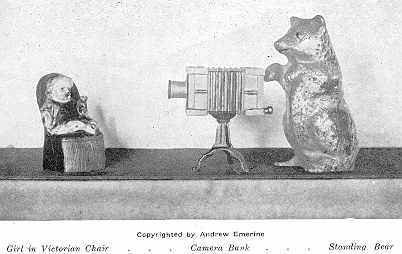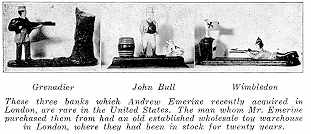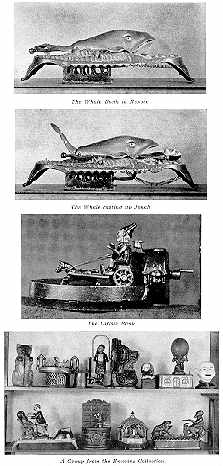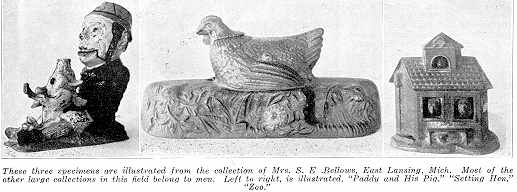HOBBIES — The Magazine for Collectors, September 1939
MECHANICAL BANKS
By Mrs. S. E. Bellows
Illustrated from the collection of Andrew Emerine, Fostoria, Ohio
THE mechanical bank was one of the first associations of thrift to the youngster of the past generation.
 In addition to being a toy, the
bank "performed," often reflecting the historical events of the country —
as is seen in the "Tammany" bank of 1873. "Boss Tweed," dressed in
fine clothes, sits. A penny is placed in his palm; he places his hand on his chest, and
deposits the coin in his coat pocket. Then smilingly he nods approval. Somehow your money
has vanished, and you do not see it again.
In addition to being a toy, the
bank "performed," often reflecting the historical events of the country —
as is seen in the "Tammany" bank of 1873. "Boss Tweed," dressed in
fine clothes, sits. A penny is placed in his palm; he places his hand on his chest, and
deposits the coin in his coat pocket. Then smilingly he nods approval. Somehow your money
has vanished, and you do not see it again.
The "Dark Town Battery" shows the colored boys of 1880 playing base ball. A coin is placed in the hand of the pitcher who throws the ball (the penny). The player strikes, and misses; the penny goes over the plate, and falls into the opening in front of the catcher. The opening closes up and the penny falls down into the recesses of the hole. The grown up, as well as the youngster, is thrilled with the performance. Grown men play with the toy and each time it performs, want it to act again.
The "Uncle Sam" bank shows Uncle Sam receiving the penny in his hand, and when the lever is pulled he drops it into his carpet bag, and nods "thank you! thank you!!" with his goatee bobbing up and down. Another bank depicts the "Carpet Bagger" days, a phase of our country’s history.
The question is often asked, "Where do you find these banks?" The answer is, "Most anywhere." Sometimes in old barks; in attics; used as door stops in farm homes and sometimes packed away in the bottom of old trunks, where the playthings of some little boy, long since gone, were kept. Probably the latter contained the very pennies placed there by the childish hand so many years before. And we pause as the memories of all these happenings come crowding into the mind as we gaze at the little old funny toy that was perhaps the prized Christmas gift of some deserving little boy, or girl, so many years ago.
Children, particularly, always get many laughs out of "Paddy and His Pig" bank. In this bank Paddy sticks his tongue out and licks the penny off the pig’s nose after the pig has given it a severe kick.

 The "Zoo" bank is a rather elusive one, because it is one of the
smaller banks. A monkey’s face appears in the upper window of the house; after the
penny is placed in the slot, at the top of the house, the monkey’s face is pressed
in, and out of the first story window pop two monkey faces.
The "Zoo" bank is a rather elusive one, because it is one of the
smaller banks. A monkey’s face appears in the upper window of the house; after the
penny is placed in the slot, at the top of the house, the monkey’s face is pressed
in, and out of the first story window pop two monkey faces.
The "Setting Hen" bank is interesting. As the penny is placed in the slot, the lever is pulled and the hen starts picking in the "grass," and out from under her feathers pops a small chick.
"Teddy and the Bear" is one of the historical banks. It depicts Teddy Roosevelt "big game hunting." A coin is placed on the end of his gun; he shoots through the slot in the tree and the coin flies into the tree; the top of the tree trunk flies up and out pops a bear. This is one of the later banks, but it always affords a great deal of amusement.
 Many different phases of life are depicted in the mechanical
banks. The dentist bank shows the dentist extracting a tooth from a colored boy. The
colored boy falls back in his chair; the dentist falls back with the tooth in his forceps,
and the penny slips from his pocket into the slot in the bank.
Many different phases of life are depicted in the mechanical
banks. The dentist bank shows the dentist extracting a tooth from a colored boy. The
colored boy falls back in his chair; the dentist falls back with the tooth in his forceps,
and the penny slips from his pocket into the slot in the bank.
Every bank has a story and one might go on at length describing them, as hundreds were made. The collector is often asked "Where were these banks made? Were they domestic, or imported? Some were made in New York State and other eastern states, also Canada, and England. They were not made in any great quantities or for any great length of time, however, as they were very difficult to make and rather hard to repair. Disregarding the fact that these banks are not too plentiful, we start collecting, and the mechanical bank becomes a popular hobby.
These banks really reflect skill and craftsmanship of the maker. Some of the specimens are exceedingly complicated in mechanism.
Andrew Emerine, banker of Ohio, and a prominent collector of old mechanical banks has this to say about his hobby:
"Back in the good old days when THRIFT seemed a virtue, even to the extent of attempting to influence the child to save its pennies, several enterprising iron foundries were competing and striving to produce the most attractive and best selling mechanical bank.
"These clever and interesting units of mechanism were constructed of intricate parts and timed to perform their respective stunts with promptness and precision. They were sold by the general store as ‘toy banks’ and presented to the boy or girl, often serving as a Christmas gift, and many a grandfather today recalls with pleasant memory his old boyhood penny bank.
"Over six hundred different varieties were made, resulting in many thousand banks being retailed between the years 1860 and 1885, some two hundred and sixty of the six hundred having moving parts and been known as ‘mechanical banks’ while the others are called ‘still banks’
"The common mechanical bank today is one of the many varieties that was produced in vast quantities, while the rare and extremely rare are the few survivors of those whose production was limited to a very few.
 "It is not so
difficult to gather in a collection of the first one hundred of the more common banks, but
it is quite difficult to acquire the last fifty after the collection has reached two
hundred in number.
"It is not so
difficult to gather in a collection of the first one hundred of the more common banks, but
it is quite difficult to acquire the last fifty after the collection has reached two
hundred in number.
"There are ten outstanding collections in the United States and practically all the known surviving rare banks are included in these collections.
